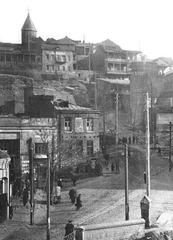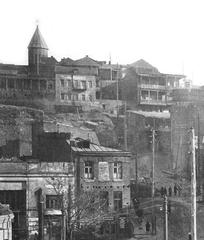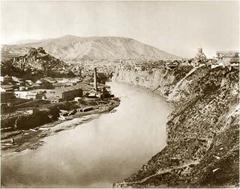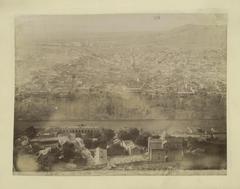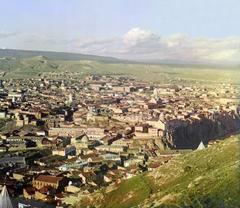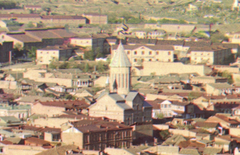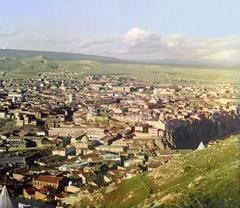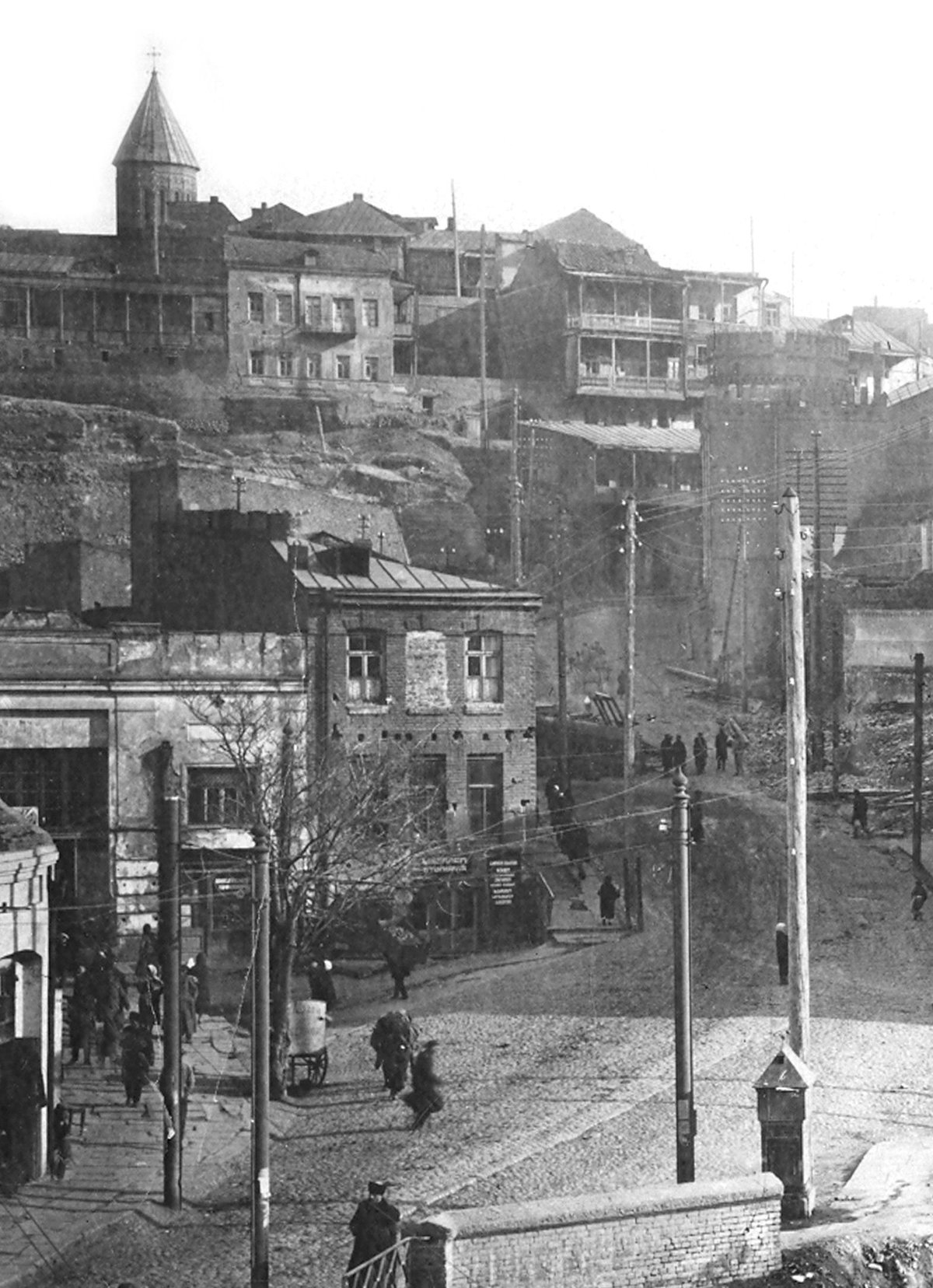
Church of the Red Gospel Tbilisi: Visiting Hours, Tickets, and Historical Significance
Date: 14/06/2025
Introduction
The Church of the Red Gospel, an evocative ruin in Tbilisi’s Avlabari district, stands as a testament to the Armenian community’s deep roots in the Georgian capital. Known locally as Karmir Avetaran Yekeghetsi (Կարմիր Ավետարան եկեղեցի) and Shamkoretsots Sourb Astvatsatsin Church, this edifice was once the tallest Armenian church in Tbilisi—a beacon of architectural splendor and communal pride (Wikipedia). Despite its partial collapse and current state of neglect, the church remains a vital symbol of resilience and cultural heritage. This comprehensive guide details its history, architectural highlights, cultural significance, visitor information, preservation status, and practical travel tips.
Table of Contents
- Historical Background and Community Context
- Architectural Features and Significance
- Destruction, Decline, and Controversy
- Cultural and Urban Importance
- Current State and Preservation Challenges
- Visitor Information: Location, Access, Hours, and Tickets
- Practical Tips and Responsible Tourism
- Nearby Attractions and Additional Resources
- Frequently Asked Questions (FAQ)
- Conclusion and Call to Action
- References
Historical Background and Community Context
The Church of the Red Gospel was established in the late 18th or early 19th century, with sources citing construction dates ranging from 1735 to 1808 (Wikipedia; Regional Post). Financed by donations from Tbilisi’s prosperous Armenian residents, the church soon became a spiritual, cultural, and social hub for the city’s largest ethnic group during the 19th century (RFE/RL). The prominence of the Armenian community in Avlabari is reflected in the church’s grand scale and the unique reddish hue of its brickwork.
Architectural Features and Significance
Design and Construction
At nearly 40 meters high, the Red Gospel was the tallest Armenian church in Tbilisi. Characterized by a traditional cruciform layout and a central cupola, its red brick construction distinguished it from the city’s stone-built Georgian Orthodox churches (Wikipedia; Madloba). Armenian-language inscriptions still visible on the remaining walls emphasize its historic and linguistic heritage.
Structural Challenges
Shortly after completion, cracks appeared in the church’s walls, necessitating periodic 19th-century repairs. Its central dome—an architectural hallmark—proved especially vulnerable, culminating in its catastrophic collapse in 1989 (Wikipedia; RFE/RL).
Destruction, Decline, and Controversy
The 1989 Collapse
On April 13, 1989, the church’s cupola collapsed. Debate endures as to whether this was caused by an earthquake or deliberate destruction, reflecting broader tensions regarding the preservation of Armenian heritage in Georgia (Wikipedia; Tripomatic).
Post-Soviet Neglect and Urban Encroachment
Following the collapse, the church was closed and suffered further deterioration, including the loss of additional walls in the 1990s and 2009 (Regional Post). Unchecked urban development—including a nearby residential building and parking lot—has further destabilized the site and severely limited access (Alpha News; Media.am).
Ownership Disputes
The Red Gospel is at the center of a protracted dispute between the Armenian Apostolic and Georgian Orthodox Churches. Its ambiguous legal status has stalled restoration efforts, leaving the church in a state of legal and physical limbo (Media.am).
Cultural and Urban Importance
For Armenians, the Red Gospel is a potent symbol of their historical presence and cultural contributions to Tbilisi. Its striking architecture once complemented the city’s diverse religious landscape, which also features Georgian Orthodox cathedrals, synagogues, and mosques (Architectural Digest; Wander-Lush). The church’s red brick walls and inscriptions continue to evoke a sense of loss and resilience amid the city’s evolving urban mosaic (Regional Post).
Current State and Preservation Challenges
Despite being designated an immovable cultural heritage monument in 2007, the church remains unprotected from environmental damage, urban encroachment, and neglect (Media.am). Fires, heavy rainfall, and unauthorized construction have further weakened the structure. The Armenian Diocese and heritage advocates continue to campaign for its preservation, but progress is slow. Community members have organized candlelight vigils and advocacy campaigns, highlighting the church’s significance and the urgency of preservation (Alpha News).
Visitor Information: Location, Access, Hours, and Tickets
Location and How to Get There
The Red Gospel Church is located on Isani Street in Tbilisi’s Avlabari district, a short distance from the Avlabari metro station. The area is accessible by metro, city bus, taxi, or on foot from the city center (Madloba).
Visiting Hours and Tickets
- Opening Hours: No official visiting hours. The church is generally viewable from public areas during daylight but is not accessible due to safety and legal restrictions.
- Admission: There is no ticket fee; entry to the grounds is typically restricted. Visitors should not attempt to enter the ruins for safety reasons.
Accessibility
Direct access is severely limited by collapsed walls, private properties, and ongoing safety concerns. The site is not wheelchair accessible, and visitors should exercise caution and avoid trespassing on adjacent private land (Media.am).
Guided Tours
No official on-site tours are available. However, some local walking tours of Tbilisi’s Armenian heritage may discuss the Red Gospel’s history and significance (Reddit).
Photography and Visitor Etiquette
Photography of the exterior is permitted from public areas. Visitors should dress modestly, act respectfully, and avoid disturbing local residents or worshippers (The Invisible Tourist).
Practical Tips and Responsible Tourism
- Best Time to Visit: Spring and autumn offer pleasant weather and fewer crowds.
- Safety: Do not approach unstable walls or attempt to enter the ruins.
- Facilities: The site lacks restrooms, ticketing, or visitor centers; nearby Avlabari offers cafes and amenities.
- Sustainable Travel: Use public transit or walk to reduce your environmental impact. Support local businesses and artisans.
Responsible Engagement
- Respect the sanctity and fragility of the church.
- Avoid contributing to wear or damage.
- Learn about Armenian culture and history through local museums and community events.
Nearby Attractions and Additional Resources
- Ejmiatsin Church: An active Armenian church nearby.
- Narikala Fortress: For panoramic views of Old Tbilisi and the Red Gospel ruins.
- Tbilisi Old Town: Explore multicultural religious and historical sites.
- Armenian Cultural Museum: For deeper insight into Armenian heritage in Georgia.
For up-to-date information, visit the Tbilisi Tourism Board or the Armenian Diocese of Georgia.
Frequently Asked Questions (FAQ)
Q: Is the Church of the Red Gospel open to the public?
A: The ruins are generally not accessible due to safety hazards and restricted access. Viewing from public streets is possible.
Q: Do I need a ticket to visit?
A: There is no entry fee or ticket required, but entry is restricted.
Q: Are guided tours available?
A: No official tours enter the site, but some city walking tours cover its history.
Q: Is the site wheelchair accessible?
A: No. The terrain is uneven and access is limited.
Q: How can I support preservation?
A: Support local heritage organizations, donate to reputable preservation funds, and spread awareness about the church’s plight.
Conclusion and Call to Action
The Church of the Red Gospel embodies both the grandeur and adversity of Tbilisi’s Armenian heritage. While its current condition restricts direct visitation, the site’s enduring symbolism calls for collaborative preservation and respectful engagement. Travelers, historians, and advocates are encouraged to support ongoing restoration efforts, explore related sites, and deepen their understanding of Tbilisi’s multicultural story.
For the latest updates, download the Audiala app, follow local heritage organizations, and plan your visit thoughtfully to contribute to the preservation of this remarkable monument.
References
- Church of the Red Gospel, Tbilisi Wikipedia article
- RFE/RL, Georgia: Tbilisi Armenian Church Collapsing Red Gospel
- Regional Post, The Disappearing Armenian Churches of Tbilisi
- Madloba, Armenian Church of the Red Gospel, Tbilisi
- Advantour, Religion in Georgia
- Media.am, Verified Report on Red Gospel Church Condition
- Alpha News, Armenian Community of Georgia Warns of Red Gospel Collapse
